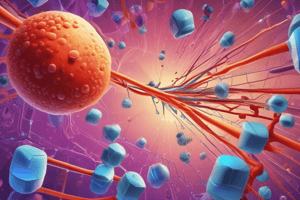Podcast
Questions and Answers
Which type of targeting exploits the natural distribution patterns of a drug carrier?
Which type of targeting exploits the natural distribution patterns of a drug carrier?
- Active targeting
- Physical targeting
- Selective targeting
- Passive targeting (correct)
What is an example of a macromolecular carrier approach in drug delivery?
What is an example of a macromolecular carrier approach in drug delivery?
- Prodrugs
- Nanoparticles
- Monoclonal antibodies
- Polymer therapeutics (correct)
Which drug delivery system is an example of a macrodevice?
Which drug delivery system is an example of a macrodevice?
- Nanoparticles
- Liposomes
- Microparticles
- Vaginal rings (correct)
Which method involves the covalent conjugation of drugs to polymeric carriers?
Which method involves the covalent conjugation of drugs to polymeric carriers?
Which targeting strategy characterizes interventions designed to actively bind to specific cells or tissues?
Which targeting strategy characterizes interventions designed to actively bind to specific cells or tissues?
What was the first monoclonal antibody to reach the market, and what was its primary use?
What was the first monoclonal antibody to reach the market, and what was its primary use?
What is a primary benefit of using prodrugs in pharmacotherapy?
What is a primary benefit of using prodrugs in pharmacotherapy?
Which property must monoclonal antibodies possess to be used as imaging agents?
Which property must monoclonal antibodies possess to be used as imaging agents?
What kind of carriers are used in macromolecular drug delivery systems?
What kind of carriers are used in macromolecular drug delivery systems?
What is the primary goal of drug targeting?
What is the primary goal of drug targeting?
In the context of drug formulation, what does 'covalently conjugated' mean?
In the context of drug formulation, what does 'covalently conjugated' mean?
Which of the following best describes monoclonal antibodies?
Which of the following best describes monoclonal antibodies?
Which of the following options represents a reason for using prodrugs?
Which of the following options represents a reason for using prodrugs?
What effect does the choice of macromolecular carrier have on drug distribution in the body?
What effect does the choice of macromolecular carrier have on drug distribution in the body?
What is an example of second-order targeting?
What is an example of second-order targeting?
What is the function of imaging agents like Oncoscint and Prostascint?
What is the function of imaging agents like Oncoscint and Prostascint?
How does a prodrug function in drug delivery?
How does a prodrug function in drug delivery?
What was Paul Ehrlich awarded the Nobel Prize for?
What was Paul Ehrlich awarded the Nobel Prize for?
Which targeting approach utilizes a carrier to transport drugs?
Which targeting approach utilizes a carrier to transport drugs?
What defines the difference between polyclonal and monoclonal antibodies?
What defines the difference between polyclonal and monoclonal antibodies?
Which of the following is NOT a characteristic of the 'magic bullet' concept?
Which of the following is NOT a characteristic of the 'magic bullet' concept?
What is the primary aim of drug delivery and drug targeting?
What is the primary aim of drug delivery and drug targeting?
Which of the following best describes modified release in drug delivery?
Which of the following best describes modified release in drug delivery?
What characteristic is NOT associated with non-conventional dosage forms in drug delivery?
What characteristic is NOT associated with non-conventional dosage forms in drug delivery?
Which approach is specifically mentioned as part of the learning objectives for drug delivery?
Which approach is specifically mentioned as part of the learning objectives for drug delivery?
What aspect of drug release can be modified in drug delivery systems?
What aspect of drug release can be modified in drug delivery systems?
Why is targeting considered difficult in drug delivery?
Why is targeting considered difficult in drug delivery?
What is the focus of the two-hour workshop mentioned in the outline?
What is the focus of the two-hour workshop mentioned in the outline?
Which textbook is indicated as a reference for drug delivery and targeting?
Which textbook is indicated as a reference for drug delivery and targeting?
Flashcards
Drug Delivery
Drug Delivery
The process of delivering a drug to its intended site of action at the correct concentration and for the appropriate duration.
Drug Targeting
Drug Targeting
A specialized approach in drug delivery that aims to concentrate the drug in a specific target area, such as a tumor or a specific organ.
Modified Release
Modified Release
Drug delivery systems designed to control the rate, time, and location of drug release.
Conventional Dosage Forms
Conventional Dosage Forms
Signup and view all the flashcards
Non-conventional Dosage Forms
Non-conventional Dosage Forms
Signup and view all the flashcards
Sustained Release
Sustained Release
Signup and view all the flashcards
Prodrug
Prodrug
Signup and view all the flashcards
Monoclonal Antibodies
Monoclonal Antibodies
Signup and view all the flashcards
Monoclonal Antibody
Monoclonal Antibody
Signup and view all the flashcards
Macromolecular Carrier
Macromolecular Carrier
Signup and view all the flashcards
Particulate Carrier
Particulate Carrier
Signup and view all the flashcards
Soluble Macromolecular Carrier
Soluble Macromolecular Carrier
Signup and view all the flashcards
Entrapment
Entrapment
Signup and view all the flashcards
Conjugation
Conjugation
Signup and view all the flashcards
Carrier Determines Distribution
Carrier Determines Distribution
Signup and view all the flashcards
Magic Bullet
Magic Bullet
Signup and view all the flashcards
Polyclonal Antibodies
Polyclonal Antibodies
Signup and view all the flashcards
3rd Order Targeting
3rd Order Targeting
Signup and view all the flashcards
1st Order Targeting
1st Order Targeting
Signup and view all the flashcards
Passive targeting
Passive targeting
Signup and view all the flashcards
Active targeting
Active targeting
Signup and view all the flashcards
Physical targeting
Physical targeting
Signup and view all the flashcards
Drug conjugation
Drug conjugation
Signup and view all the flashcards
Study Notes
Advanced Drug Delivery (PM3PY2) - Study Notes
- Course Information:
- Module: PM3PY2
- Lecturer: Prof Francesca Greco
- Email: [email protected]
- Office: Chemistry building 1.15
- Course content focuses on advanced drug delivery and drug targeting, including lectures, a workshop, and final exam assessment.
Lecture Outline
- Lectures: Six lectures covering advanced drug delivery and drug targeting.
- Workshop: Two-hour workshop on advanced drug delivery.
- Assessment: Exam included in the PM3PY2 final exam.
References
-
Required Textbooks:
- Drug Delivery and Targeting (Hillery, Lloyd & Swarbrick), published by Taylor and Francis
- FASTtrack: Pharmaceutics - Drug Delivery and Targeting (Perrie & Rades), published by Pharmaceutical Press
- Martin's Physical Pharmacy and Pharmaceutical Sciences, Chapter 22: Drug delivery systems
- Ansel's Pharmaceutical Dosage Forms and Drug Delivery Systems, Chapter 20: Novel Dosage Forms and Drug Delivery Technologies
-
Additional Textbooks:
- Engineering Polymer Systems for Improved Drug Delivery (Bader & Putnam), 2014, Wiley
- Fundamentals of Pharmaceutical Nanoscience (Uchegbu, Schätzlein, Cheng & Lalatsa), 2014 (Springer, new edition coming 2024)
Learning Objectives (Lecture 1)
- Understand drug delivery and drug targeting concepts.
- Learn relevant terminology for drug delivery.
- Understand different drug delivery approaches, including monoclonal antibodies and prodrugs.
Drug Delivery/Targeting Definition
- The goal is to deliver a drug to the correct location in the body at the right time and concentration. Simply being pharmacologically active isn't enough, the drug needs to be at the right place.
Terminology for Drug Delivery / Drug Targeting
- Modified Release: A comparison to conventional release strategies.
- Conventional Dosage Forms: Drug release and plasma levels are based on the physicochemical properties of the active ingredient.
- Non-Conventional Dosage Forms: Drug release and plasma levels are based on the technological characteristics of the formulation.
Drug Release Aspects
- Rate: Examples include very fast release and sustained release.
- Time: Release starts at a certain time after administration.
- Space: Release happens in specific areas or tissues (targeting).
Why Targeting is Important
- Targeting Bacterial Infections: Differences exist between bacterial and mammalian cells.
- Targeting Cancer: Understanding the differences between cancer and healthy cells is critical for effective targeting; the differences are significant and difficult to overcome.
Selective Target Concept
- Magic Bullet: A potent and selective active ingredient, pioneered by Paul Ehrlich (Nobel Prize 1908).
Ordering of Targeting Mechanisms
- 1st Order Targeting: Organ or tissue targeting (e.g., liver targeting).
- 2nd Order Targeting: Specific cell targeting (e.g., tumor cells).
- 3rd Order Targeting: Intracellular compartment targeting (e.g., lysosomes).
Approaches to Targeting
- Magic Bullet: A potent and selective active ingredient.
- Prodrugs: Inactive prodrug is activated at the target site.
- Macromolecular Carrier: A carrier delivers the drug to the desired location.
Monoclonal Antibodies (Magic Bullet Approach)
- General Structure: Antibodies have specific structures.
- Polyclonal Antibodies: Target various antigens.
- Monoclonal Antibodies: Target a single antigen.
- Timeline: Developed in 1975.
- Commercial Applications: Diagnosis (e.g., RIA, ELISA) and treatment (e.g., immunosuppressants, anticancer agents).
- Examples: OKT3 (for preventing kidney transplant rejection), Trastuzumab (Herceptin®) for HER-2 positive breast carcinoma.
- Imaging Agents: Conjugated with diagnostic imaging agents to pinpoint cancer cells. Examples include oncoscint (colon/ovarian) and prostascint (prostate).
Prodrugs
- Definition: Chemically and pharmacologically inactive derivatives of a drug that undergo activation at the target site.
- Reasons for Use: Improved membrane permeability, site-specific administration, increased duration of action, and reduced toxicity/side effects.
Macromolecular Carriers
- Characteristics: Biologically inert macromolecules (usually polymers).
- Types: Particulate and soluble macromolecular carriers.
- Drug Delivery Methods: Drug can be entrapped in the carrier or covalently conjugated.
- Types of Targeting: -Active targeting: Carrier is guided to a specific target through a specific interaction mechanism. -Passive targeting: Exploits the natural distribution pattern. -Physical targeting: Drug carrier is physically guided to the target site.
Technologies Used in Drug Delivery/Targeting
- Polymeric Matrices: Controlled drug release.
- Monoclonal Antibodies/Antibody-Drug Conjugates: Targeting.
- Prodrugs: Site-specific activation.
- Liposomes, Microparticles and Nanoparticles: Drug carriers.
- Micelles: Drug carriers and drug-polymer conjugates
Sizes of Delivery Systems and Devices
- Categorized into Molecular (e.g., monoclonal antibodies), Nano (e.g., nanoparticles), Micro (e.g., microparticles), and Macro (e.g., implantable devices, vaginal rings).
Studying That Suits You
Use AI to generate personalized quizzes and flashcards to suit your learning preferences.




